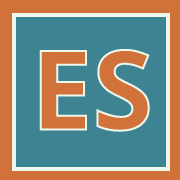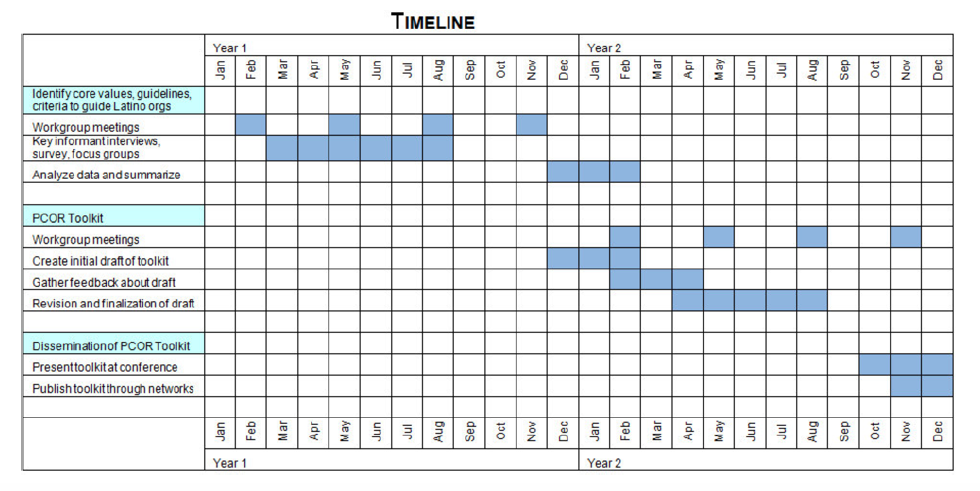Toolkit Menu
Standards of Engagement
Be Focused on PCOR & Patient Engagement
The organization must be committed to:
- Applicability (applying results) - meaningful consequences for patient quality of life and community health
- A focus on impact that we can measure
- Honoring commitments - “Doing what we say we will do”
- Ensuring clear expectations amongst stakeholders (including organizational leadership, personnel, and patients) and empowered, autonomous participation
What needs to be in place for the organization in general:
- Effective communication - internally and with patients/partners that is transparent and respectful
- Decision making process across organizational levels that is understood by all parties and represents a mutual effort
What needs to be in place when considering a particular research project:
- Adequate time and resources devoted to project (for both the organization and patients)
- Everyone (leadership and staff) understands the commitment to the funder and partners
- Discipline ourselves to ask the question “How does this strengthen patient empowerment, relationship with organizations, and treatment outcomes”
Be Grounded in Cultural Competence
The organization must be committed to:
- Adequate number and diverse Latino patient representation (not just token)
- Inclusion of Latino patients’ perspective and insights throughout the partnership (not just attendance)
What needs to be in place for the organization in general:
- Systematic stakeholder discussion - a system to bring together community, patients, providers and researchers at a given time to determine research questions, involvement, agenda, etc.
- Ongoing collaborative partnerships - in harmony with mission and goals of person or organization - not just a one-time project
- A common understanding of what PCOR is - through education & training - both for the organization and for patients, partner organizations & researchers
What needs to be in place when considering a particular research project:
- Meaningful representation of Latino patients and perspectives in the discussion
- Patient influence - understand how Latino patient participation influences research study design and results
Include a Plan for Sustainability of Efforts
The organization must be committed to:
- An ongoing relationship between all involved partners
- Developing infrastructure for facilitating ongoing research
What needs to be in place for the organization in general:
- Realistic consideration of costs - both direct and indirect
- Commitment to long term engagement with a trusted partner
- Protected time and space for research activities
What needs to be in place when considering a particular research project:
- Alignment with organization goals - clear understanding of how the project fits within larger organizational goals and works toward them in broader timeline
- Defined plan for transitioning from project to next phase of partnership toward ongoing goals
Show How Knowledge Is Improved
The organization must be committed to:
- Applicability (applying results) - meaningful consequences for patient quality of life and community health
- Accountability and transparency with research process
- Improved “translation” - sharing findings in a way that allows them to affect the world around us
What needs to be in place for the organization in general:
- A plan for giving ongoing research updates to everyone involved and applying feedback received
What needs to be in place when considering a particular research project:
- The development of the proposal and implementation of the project includes insights from patients and stakeholders
- There is a plan for dissemination and implementation
STEP 2: Project Planning & Design
This section guides how to solidify the project plan once a decision is made to participate in a research project. The identified PCOR Standards of Engagement reflect that the ideal scenario is for representatives of all project stakeholders to be involved in this Project Planning and Design phase, prior to submitting any letters of intent or funding proposals. The result is a funding proposal that reflects all stakeholder priorities and promotes strong and sustainable research partnerships.
Recommendations
 1. Bring together a Research Leadership Team to make initial key project decisions to move the project beyond the concept to flesh out a realistic plan. *
1. Bring together a Research Leadership Team to make initial key project decisions to move the project beyond the concept to flesh out a realistic plan. *
This team, made up of representatives from primary stakeholders, will drive the project forward from design through funding and implementation to completion, and will make key project decisions.
The Research Leadership Team should:
- Review the initial Project Summary and make any necessary revisions.
- Identify key areas of the project design process to engage community input.
- Establish decision-making processes that align with the missions and values of the partnering entities, including the community/patient representatives.
- Identify the additional voices important to have at the table to achieve equitable representation from three key perspectives: patient, Community Based Health Organization Serving Latinos (CBHOSL), and researcher.
The Research Opportunity Review Framework should at least include the following:
- Research Leadership Team. Developing this committee will provide a mechanism and structure for responding to internal and external research opportunities as they arise, guiding a process that considers fit, capacity, equitable community engagement, and the PCOR Standards of Engagement at every step.
- Your organization’s Guiding Research Priorities. All research opportunities should fit within these and help to move them forward. Include an understanding of the mission, values, current strategic goals, and research priorities. Definition of the information needed from a Project Summary in order to have enough relevant information to guide decision making about whether to participate.
- PCOR Standards of Engagement as a checklist for whether the opportunity meets Patient Centered Outcomes Research (PCOR) standards.
- Policy on Patient Involvement in Research & Principles of Community Engagement to ensure equitable, culturally aware, and socially just practices. This Policy should adhere to equitable Community Engagement Principle and Priorities focused specifically on working with Latino
communities.
2. Hold a meeting with all proposed project partners, including equitable representation from the targeted community.
This helps shape the project according to community needs as well as gaining buy-in for project participation.
- Recruit community members (patients and representative voices) for the kickoff meeting: A Policy on Patient Involvement in Research & Community Engagement Principles can promote equity and support lasting relationships that will empower the project.
- A meeting agenda should include at least the following:
- Introduction to the project and all partner organizations / entities.
- Share a Summary of Community Needs as they are presently understood. Ask if results are compatible with the community members’ lived experience, and revise as necessary based on responses.
- Share initial representation of the Research Questions and gather feedback to help shape:
- Will these questions result in outcomes that matter to the community?
- Does the community have recommendations for how to make these questions matter more, or be more compatible with the Summary of Community Needs?
- Do these questions align with participant values?
- Include next steps so that stakeholders know what happens next.
3. Out of the meeting with all potential stakeholders, the Research Leadership Team should develop an Updated Project Summary with three important elements spelled out:
1) A culturally competent plan for recruiting patients to guide efforts to engage patients in the project.
2) A Research Methodology
- Develop a framework to ensure focus on PCOR.
- Make the research a seamless part of patient care.
- Remain flexible in order to adapt research methodology according to the ground realities specific to the population participating in the study. Rely on the Summary of Community Needs, lived experience, and ongoing understanding to remain aware of these ground realities and adapt to them.
- Solidify the Research Questions.
- Develop the Data Collection, Management, and Analysis Methods.
3) A detailed Project Workplan to guide funding proposal development and subsequent project activities includes:
- Project Timeline – We have found a Gantt chart helpful because of the way it graphically communicates information. Here’s an example of the one we used in developing this toolkit:
- Personnel Roles and Responsibilities – Here are some aspects to remember in planning:
- Ensure adequate time and resources are dedicated for ongoing relationship development with the partnering entities;
- Encourage buy-in from front-line staff to be engaged in the project;
- Update the Organization Chart based on these decisions. Ensure that these roles are not simply added to existing full-time jobs, and that there are contingency plans for what happens if there is staff turnover or similar changes.
3. Maintain a list of potential opportunities and funding entities.
Examples of ways to build this awareness include:
- Notice and document sponsors of the projects whose findings you read in articles of interest to your work.
- Reach out to the researchers and organizational partners with whom you have developed relationships. Inquire whether they have ideas of funders who might be interested in your idea.
- Attend conferences relevant to your research priorities, and notice the sponsors of the conferences or the research presented.
- Keep these documents active and alive, continually adding information as new individuals or ideas are identified.
- Assign this task to a staff member with routine updates and maintenance.
- Remember to update this document after conference attendance, partnership meetings, community gatherings, or key conversations in which interested parties or research ideas are identified.

